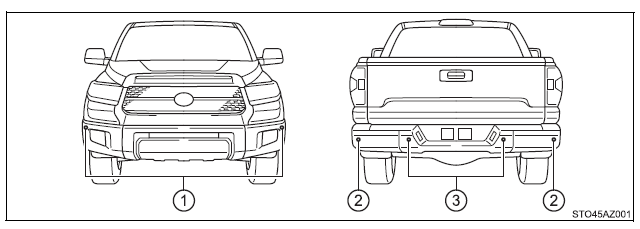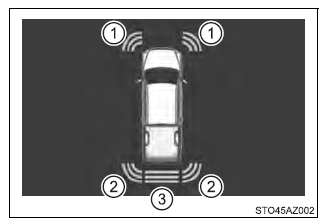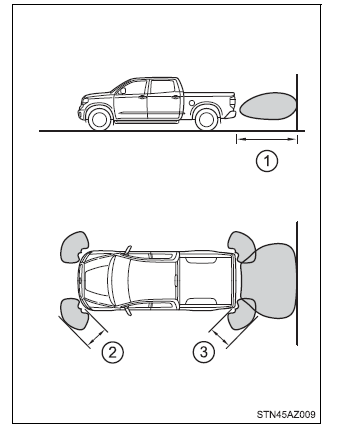The distance from your vehicle to nearby obstacles when parallel
parking or maneuvering into a garage is measured by the
sensors and communicated via the multi-information display
and buzzer. Always check the surrounding area when using this
system.
■ Types of sensors

- Front corner sensors
- Rear corner sensors
- Rear center sensors
■ Intuitive parking assist switch
Turns the intuitive parking
assist on/off
When on, the indicator light
comes on to inform the driver
that the system is operational.

The distance display and buzzer
When the sensor detects an obstacle, the direction of and the approximate
distance to the obstacle are displayed and the buzzer sounds.
■ Intuitive parking assist display
- Front corner sensor operation
- Rear corner sensor operation
- Rear center sensor operation

■ Sensor operation and distance to an obstacle
The system operates when the vehicle approaches an obstacle, as
shown by the following table.
When 2 or more obstacles are detected simultaneously, the buzzer system
responds to the nearest zone.
Front corner sensors

Rear corner sensors

Rear center sensor

■ When multiple obstacles are detected in front and behind the
vehicle at the same time
The buzzer will change in the following manner.
- If an obstacle has been detected within 1.5 ft. (45 cm) of the front
or 2.8 ft. (85 cm) in rear of the vehicle (a continuous buzzer is
sounding), and a new obstacle is detected at the other end of the
vehicle, the buzzer will sound 7 times then 1 continuous buzzer.
- If an obstacle has been detected within 1.5 ft. (45 cm) of the front
or 2.8 ft. (85 cm) in rear of the vehicle (a continuous buzzer is
sounding), and a new obstacle is detected in the same way at the
other end of the vehicle, the buzzer will sound 3 times then 1
continuous buzzer.
■ Detection range of the sensors
- Approximately 5.9 ft. (180 cm)
- Approximately 2.0 ft. (60 cm)
- Approximately 2.8 ft. (85 cm)

The diagram shows the detection
range of the sensors. Note that the
sensors may not be able to detect
obstacles that are extremely close
to the vehicle.
The range of the sensors may
change depending on the shape of
the object, etc.
■The intuitive parking assist can be operated when
- Front corner sensors:
- The engine switch is in the "ON" position.
- The shift lever is in R.
- The shift lever is not in P or R and vehicle speed is less than
about 6 mph
(10 km/h).
- Rear corner and rear center sensors:
- The engine switch is in the "ON" position.
- The shift lever is in R
■Certification (Canada only)
This ISM device complies with Canadian ICES-001.
| WARNING ■When using the intuitive parking assist
Observe the following precautions.
Failure to do so may result in the vehicle being unable to be driven
safely
and possibly cause an accident.
- Do not use the sensor at speeds in excess of 6 mph (10 km/h).
- The sensors' detection areas and reaction times are limited.
When moving
forward or reversing, check the areas surrounding the vehicle
(especially
the sides of the vehicle) for safety, and drive slowly, using the
brake to
control the vehicle's speed.
- Do not install accessories within the sensors' detection areas.
|
| WARNING ■Sensor detection information
Pay particular attention to the following instances in where this may
occur.
Failing to do so way result in the vehicle being unable to be driven or
parked
safety and possibly cause an accident.
- The sensor's detection areas are limited to the areas around the
vehicle's
front corner and rear bumpers.
- Certain vehicle conditions and the surrounding environment may
affect the
ability of the sensor to correctly detect obstacles. Particular
instances
where this may occur are listed below.
- There is dirt, snow or ice on the sensor. (Wiping the
sensors will resolve
this problem.)
- The sensor is frozen. (Thawing the area will resolve this
problem.)
- The sensor is covered in any way.
- The vehicle is leaning considerably to one side.
- On an extremely bumpy road, on an incline, on gravel, or on
grass.
- The vicinity of the vehicle is noisy due to vehicle horns,
motorcycle
engines, air brakes of large vehicles, or other loud noises
producing
ultrasonic waves.
- There is another vehicle equipped with parking assist
sensors in the
vicinity.
- The sensor is coated with a sheet of spray or heavy rain.
- The vehicle is equipped with a fender pole or radio antenna.
- The bumper or sensor receives a strong impact.
- The vehicle is approaching a tall or curved curb.
- In harsh sunlight or intense cold weather.
- The area directly under the bumpers is not detected.
- If obstacles draw too close to the sensor.
- A non-genuine Toyota suspension (lowered suspension, etc.)
is
installed.
- A backlit license plate, license plate holder, etc., are
installed.
- People may not be detected if they are wearing certain types
and coloring
of clothing.
- People, animals, and moving objects may not be able to be
detected.
In addition to the examples above, there are instances in which,
because of
their shape, signs and other objects may be judged by the sensor to be
closer than they are. |
WARNING
- The shape of the obstacle may prevent the sensor from detecting
it. Pay
particular attention to the following obstacles:
- Wires, fences, ropes, etc.
- Cotton, snow and other materials that absorb sound waves
- Sharply-angled objects
- Low obstacles
- Tall obstacles with upper sections projecting outwards in
the direction of
your vehicle
- The following situations may occur during use.
|
| NOTICE ■When using intuitive parking assist-sensor
In the following situations, the system may not function correctly due
to a
sensor malfunction, etc. Have the vehicle checked by your Toyota dealer.
■Notes when washing the vehicle
Do not apply intensive bursts of water or steam to the sensor area.
Doing so may result in the sensor malfunctioning. |
|